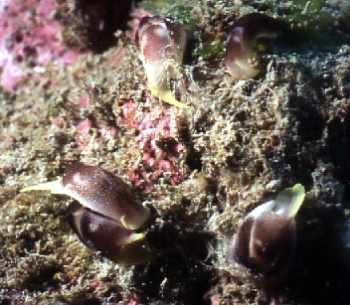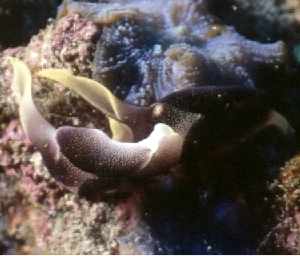Chelidonura amoena population explosion in Taipei
April 27, 2002
From: Todd Garthwaite

Hi Bill,
Here are some shots of different Chelidonura amoena, which I came across at a dive site called "Beyond-The-Rocks" which is located in Dragon Cave Bay, Taipei County's N.E. Coast, Taiwan.
Date: 20 April 2002
Time: between 10:34 - 11:17am
Depth: between 10 - 19.5 meters
Temp: 21 degrees C.
Two weeks before taking these pictures, I hadn't seen a single nudibranch around this site, with the exception of one small Phyllidia varicosa (which is the most common species around here). Imagine my surprise, when 2 weeks later I encounter a mind-boggling population explosion of Chelidonura amoena. There were hundreds upon hundreds of this particular species spread out all over the Bay. (Many of them were nestled or curled up next to each other. Although I'm not sure if they were mating, a great many of them seemed to be taking a very close interest in one another). To be honest, it was quite exciting, as I have never seen anything like it! First of all, C. amoena is not seen very often in Dragon Cave Bay, and secondly, in the 4 years that I've been diving at Dragon Cave Bay, I've never seen dozens, never mind hundreds and hundreds, of nudibranchs -- be it one species (as in this situation), or 20 different species combined. I am certainly confused as to why the sudden population explosion. My only speculation is that this spring, here in Taipei, we've been having a drought. There has been no rain for nearly 3 ½ months, which is extremely unusual for this time of year. Without the heavy rains that normally come around this time of year, I suspect Dragon Cave Bay has been suffering a lot less from the usual mud and silt caused by the run-off that comes downstream and into the bay from the nearby mountains. Without the usual amount of silt and run-off going into the water, perhaps something that pertains to the diet of C. amoena has had a chance to grow more abundantly, thus accounting for the enormous population explosion. Whatever the reason, it was exciting to see!
Stay golden.
Life, liberty, & the pursuit of nudis
Todd Garthwaite
(Taipei, Taiwan)
typhoontoddy@yahoo.com


Dear Todd,
Population explosions like this are certainly exciting to see, especially when they are an animal which usually seems rare. I have over the years at times seen large populations of a number of different species of Chelidonura in different parts of the Indo-West Pacific. I guess they result from a number of particularly fortuitous events, starting with the survival in a group of a large population of veliger larvae in the plankton, which are able to settle together and successfully survive together to adulthood. This would, among other things, require a good supply of food. We think that all species of Chelidonura feed on small flatworms, so if you are back at the same place it might be worth having a look for a plague of flatworms. Have a look at Haruo Kinoshita's message about an acoel flatworm for a photo of the most likely food of Chelidonura.
Best wishes,
Bill Rudman
Related messages
-
Color variation in Chelidonura amoena from Lembeh
From: Mike Krampf, July 27, 2007 -
Re: Chelidonura amoena piggyback
From: Kristin Anderson, July 17, 2007 -
Chelidonura amoena piggyback
From: Kristin Anderson, July 12, 2007 -
Re: Chelidonura amoena from the Philippines
From: Jose Victor Santos, May 15, 2007 -
Re: Are Chelidonura electra and C. amoena the same?
From: Roberto Sozzani, November 24, 2006 -
Are Chelidonura electra and Chelidonura amoena one species?
From: Linda Ianniello, November 22, 2006 -
Chelidonura amoena from Malaysia
From: Asther M. Lau, August 12, 2006 -
Chelidonura amoena from Komodo, Indonesia?
From: Robert Whitton, July 26, 2006 -
Chelidonura amoena in Taiwan
From: Alex Tattersall, July 25, 2006 -
Pre-mating Ritual - Chelidonura amoena
From: Mike Krampf, June 7, 2006 -
Chelidonura amoena from Derawan, Indonesia
From: Gennaro Ciavarella, December 13, 2005 -
Chelidonura amoena in Malaysia
From: Asther M. Lau, September 11, 2003 -
Chelidonura amoena at Pulau Redang
From: Kheong Sann Chan, September 11, 2003 -
Chelidonura amoena - shape and colour variation
From: Atsushi Ono, July 2, 2003 -
Chelidonura amoena mating
From: Paul Whitehead, June 21, 2003 -
Chelidonura amoena population explosion
From: Todd Garthwaite, May 24, 2003 -
Re: Chelidonura amoena spawning
From: Nishina Masayoshi, May 12, 2003 -
Chelidonura amoena spawning.
From: Johny Leffelaer, May 9, 2003 -
Chelidonura amoena from Malaysia
From: Kelvin Tan, April 24, 2003 -
Cross-species matings - Chelidonura
From: Richard Willan, April 10, 2003 -
Twin Tail Nudibranch from Malaysia
From: Spencer Huang, October 10, 2002 -
Chelidonura amoena from Malaysia
From: Richard Houghton, July 19, 2002 -
Chelidonura amoena from Malaysia
From: Maliza Anuar, July 19, 2002 -
Chelidonura flavolobata? from SE Sulawesi
From: Lindsay Warren, June 16, 2002 -
Re: Chelidonura amoena population explosion
From: Todd Garthwaite , June 10, 2002 -
Chelidonura amoena from Christmas Island
From: W.B. Rudman, April 30, 2002 -
Chelidonura amoena from Taiwan
From: Todd Garthwaite, April 1, 2002 -
Chelidonura amoena - colour variation
From: Nishina Masayoshi, February 21, 2002 -
Chelidonura amoena from the Philippines
From: Mary Jane Adams , June 16, 2001 -
Chelidonura cf. amoena from SE Sulawesi
From: Lindsay Warren, March 1, 2000 -
Chelidonura amoena from the Philippines
From: Erwin Koehler, May 1, 1999
